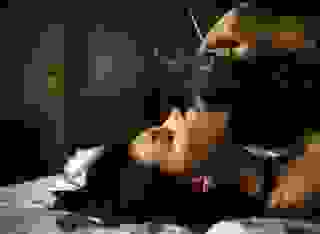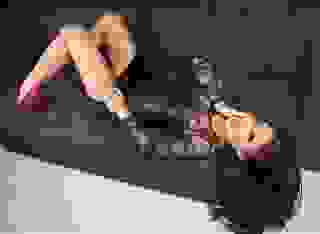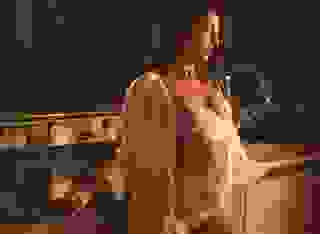Note: You can change font size, font face, and turn on dark mode by clicking the "A" icon tab in the Story Info Box.
You can temporarily switch back to a Classic Literotica® experience during our ongoing public Beta testing. Please consider leaving feedback on issues you experience or suggest improvements.
Click here"No, Princess, but if we always sent robots when there's danger, then we'd be out of a job."
"The way I see it," Rob added, surreptitiously adjusting his eye patch, whose strap tended to ride up on his bald head, "most jobs us riggers do are because robots can't do them. But sometimes we do a better job than robots; and sometimes we're cheaper than robots. I don't mind undercutting robots. It's not like we're badly paid."
"We're very well paid," Chris agreed. "But it's not just about undercutting robots. I bet you feel it yourself now, Princess, that there's something better than an office job or a laboratory job. Out on the rigs, there's a sense of adventure."
"Aye," Geraint agreed, "it's not the danger, look you. It's doing good work despite the danger."
Danielle had to agree about the sense of adventure. She felt it herself and formulated a theory to explain the feeling. She proposed that there were 'doing-jobs' and what she somewhat contemptuously called 'talking-jobs'. It was hard for ordinary blokes to find good doing-jobs because robots were stronger, faster and never got tired. Women could always find talking-jobs, especially on Earth where so many people worked for governments. But, for an ordinary bloke to feel like a man, he needed a doing-job.
That was why Rob and Chris insisted on joining the next mission, regardless of their injuries.
Seeing this, Danielle admitted that Ellen was right, though she still hated the woman. What she disliked most was how Ellen used her beauty to get her own way.
Honey blonde hair and light-blue eyes, a petite but curvy, sexy figure (of which she showed more in the office, by means of low-cut tops and split skirts, than was strictly professional), Ellen was aged forty and exuded all the power of a woman at the height of her sexual allure. She vamped the men and got her way in everything. It offended Danielle's ideal of a sexless workplace that even her boys obeyed Ellen happily and could not see that she was as hard as nails underneath.
The worst thing was that kindly old Stephen Oakshott was too soft to see what a vixen his engineering team manager was.
2MC10
One-by-one, the men returned to the bridge of the survey ship and buckled themselves into their flight seats for the few minutes of weightless cruising before entering the hyperspace beacon. The navicomms computer lined the ship up with the beacon and turned off the ion drive, stopping the acceleration.
The beacon was a big grey ring containing a purple lens made from charged particles. This was the hyperspace 'plume': the connection to a beacon eighty light-years distant, near Hydrus Space Station.
They shot into the plume. After two seconds of flickering static in the forward camera windows, the picture cleared and the stars changed. They emerged from the beacon into the Hydrus solar system.
Hydrus was a young hot blue star, large and active, a billion miles away. It had no planets but a forest of solar collectors trapped its energy, beaming the power in gamma streams to Hydrus Space Station and to a dozen hyperspace beacons in the same orbit. The onward beacon to Mu Carinae was a barely visible dot, 300,000 miles distant. The ion drive came on again with a humming vibration, building up the ship's acceleration, pushing the crew into the bottom of their seats.
The survey ship was designed to accelerate at 1g, nearly 10 metres per second squared. This made travel comfortable by causing an Earth-normal artificial gravitation, unlike the poor substitute for gravity produced by the magnestrip suits and magnetic ship-floors, used during periods of weightless cruising.
1g was the ideal acceleration for passenger liners, survey ships and most other kinds of vessel. Space ships that could ignore the cost of fuel, such as military cruisers, accelerated for short periods at higher rates, limited only by concern for the health of crew-members.
The riggers were used to snatching sleep whenever they could. They made good use of the two hours down-time to retire to their bunks. Geraint stayed on the bridge with Danielle, who did not feel tired.
They looked up the specifications of the armed missile cruiser mentioned by Eddie Vane and checked both ships' trajectories on the star map projected by the guidance system. Chafing at the time it took to travel between the beacons, Danielle said:
"It would be much easier if we could change direction inside a hyperspace plume. We could enter some kind of junction and come out of any beacon we liked. It would save hours of time and tonnes of fuel."
"It can't be done, Princess," Geraint said.
"You mean it hasn't been done yet."
"Right you are, Princess. You'll do it. It'll be your contribution to science."
Danielle smiled at Geraint's trust in her scientific genius. He was as ambitious for her as she was for herself.
A light on the navicomms station flashed to show receipt of a new message from a comms probe. It was from Ellen Carswell to any ship from Oakshott Engineering on its way to join the rigging team at Mu Carinae.
"We're on MC10 helping evacuate the miners," she reported. "Everyone is off the asteroid except for five miners said to be trapped in a shaft.
"The lads are looking for them in the south-east quadrant. Our radios are working, so I'm going down to the control room to see if I can patch into the leaky-wire comms system and contact the miners.
"When the boys have rescued the miners, I'll climb up one of the access tubes and follow them out. Let's hope there are no more electromagnetic pulses."
******
Two hours later, with the rested crew back in their flight seats, the survey ship leapt between hyperspace beacons and emerged seconds later at Mu Carinae to a scene of cosmic devastation.
The bright orange star was an epicentre of violence. Huge flares erupted from its surface, curving back in giant arcs. Shockwaves in great concentric rings pushed clouds of dust through the asteroids, their compressed wavefronts picked out in blood-red lines. Phase-shifts in the electromagnetic flux made irregular spokes through the rings.
Bigger asteroids, like MC10, magnetised by electric pulses from the star, spun wildly, careering in jerky spirals toward the star, dragging long trains of boulders behind them.
The survey ship's navicomms system holoprojected a zoomed-in image of the engineering station. Carina Sunspark was dark, cold and lifeless: not what an engineering station should be like.
A sad pall hung over the rigging team.
"Forget it, boyos," Geraint said. "We'll rescue our team first, then we'll fix the station."
The trajectory of MC10 was still toward a collision with Carina Sunspark. Despite the disturbed motion of the asteroid belt, the team risked manoeuvring to the far side of the asteroid-mine, where their ship would be shielded from the violent star but close enough to reach the asteroid in twenty minutes by rocket launch.
It was worrying that there were no communications from Ellen or rigging team A. They should have picked up something on the radio bands.
Leaving Chris with his broken leg on the survey ship, the crew of five riggers and their engineer took the rocket launch to the asteroid-mine.
MC 10 was an irregularly-shaped dark-grey rock, pockmarked by entrances to the mines and leftover surface excavations.
They flew into an open tunnel and landed one-hundred yards inside, before a sealed airlock door. This was level 1. It was from here that the ore and minerals were loaded onto freighters and sold around the settled galaxy.
Level 1 tunnels were open to the vacuum of space. The inner part of the asteroid-mine, levels 2 to 37, where the mining-machines and the human miners worked, had an atmosphere, though not always a perfectly reliable one.
The level 2 access tunnels were wide enough for the rocket launch, but the outer door would not work automatically, so the team put on their oxygen masks and took as many tools as they could manage, tied them with netting, and pushed the bundles through the personnel hatch.
Off the wider access tunnels were smaller tunnels, twenty feet in diameter, the width of the mining machines. These were exhausted mine-shafts, sealed on their floors and walls with a concrete made from crushed rock. Normally well lit, they were now dark, except where the rigging team's torchlights made mineral deposits in the walls sparkle brightly.
Inside, there was air enough to breathe, so the team took off their restrictive oxygen masks.
Without motor transportation, the rigging team used their muscles, kicking off the floor or walls to float along to the next junction. Static-charged dust collected on their flight-suits as they descended through the labyrinthine asteroid, heading for level 37, the lowest level, from which access tubes cut through 120 feet of solid rock to the control room.
MC10 was a honeycomb of criss-crossing shafts, with thick pillars of rock left in place to prevent the hollowed-out asteroid from collapsing. Even so, as they descended the levels, Danielle and the riggers saw evidence of massive geological trauma. The energy blast from the star that fried the door mechanisms and magnetised the asteroid also increased its spin, making torsions where different levels of the mine tried to rotate at different speeds.
There were cracks in the supporting pillars and the rocky walls groaned as they settled. Fragments of rubble floated haphazardly in the tunnels. Dust hung in clouds, turning the white lights of their torches yellow.
There was no radio contact with Ellen or the riggers. They tried a few times but got only static.
The top twenty levels had been mined out, leaving neat horizontal and vertical shafts. In the lower levels, where rougher shafts were still being worked, mining machines were parked inertly in the tunnels, their batteries drained or their electronics shorted.
Lower down, the groans and cracks of the re-settling pillars stopped. It was eerily silent. Any noise, even a whisper, echoed for minutes, rebounding from the distant ends of the tunnels. It made the lads want to be silent themselves, rather than have their own voices reverberate in the dead asteroid.
There was a system of buckets to transport ore to the upper levels through the vertical tunnels. It was stalled. Empty scoops hung uselessly on the downward side of the conveyor, while dust spilled from ore-filled scoops on the upward side, swaying on their gimbals but going nowhere.
At the end of a tunnel on level 30, the team reached a vertical shaft to take them directly to level 37. They shone their torches into the hole, lighting the eerie blackness. Motes of dust jigged in the bright beams.
The ladders on the side of the shaft looked secure but it was quicker to jump, so the lads pushed the netted tools into the shaft and sent them downward with hard shoves. They launched themselves after the tools. Danielle went last, kicking off opposite walls to float down in a zigzag course, taking a good look at the integrity of the rock as she went. There was damage at every level.
On level 37, at a radius of 120 feet from the control room in the middle of the asteroid, there was a latitudinal shaft around the equator of the asteroid and a longitudinal shaft that went through both poles.
There were six access tubes to the control room. Four were horizontal tubes, at the south-east, south-west, north-east and north-west points. Two were vertical tubes at the north and south poles. Each access tube had an airlock outside and a ladder inside.
With six team-members and six access tubes, Geraint simply assigned each member a tube to check and told them to be back in fifteen minutes.
Danielle, Geraint, Rob and Gil took the horizontal tubes. They returned in less than five minutes, saying that the tubes were all inaccessible, sheared off by the magnetic shockwaves rotating the levels of the asteroid at different rates.
Jake, the boy rigger, arrived a few minutes later, saying that the south-pole tube was blocked near its entrance by a pillar collapse.
This left Mack, who came back panting.
"The north-pole tube is blocked about fifty feet down," the black-haired man said, wiping away the sweat that channelled a grimy path down his dust-grey face. "The rock itself has shifted, twisting the tube. It's too narrow for any of us to get through."
"How narrow is the restriction?" Danielle asked.
"About two feet wide and less than a foot deep."
"I can get through," she said.
There was an argument with Geraint, which Danielle won. The men did not like it but they had to agree there was not enough time to search for the riggers and fetch the heavy plasma torch from the launch, to burn a man-size hole through the asteroid's core to the control room.
They loaded Danielle up with two oxygen tanks, hand-tools and a water bottle. An air hose and a combined comms and power line were tied to her utility belt. She could attach the comms line and air pipe to the external ports of the control room. The lads set up a fuel cell for the power cable and an oxygen tank with a pump for the air pipe.
Geraint plugged his personal communicator into the sender-receiver unit at one end of the comms line. Danielle did the same at her end.
She swapped the lip-gloss in her utility belt for a laser penknife and tied her hair up out of the way. She clipped the oxygen mask to her collar but did not plan to put it on unless she really needed to.
Danielle opened the airlock and started down the ladder, feet first.
The first constriction, nearly fifty feet down, where the access tube was trapped by a twisted layer of solid rock, went for at least thirty feet. That was why Mack could not cut a path through for himself without hours of work.
She shone the laser penknife into the blackness and saw a narrow gap through, with bent railings from the ladder criss-crossing the path. While the access tube was wide enough for her to perform an agile manoeuvre, she turned around and faced head-first down the tube. Tying the oxygen bottles to her belt with long cables, she pushed them through the gap.
Descending weightlessly, pulling on the bent rungs, her laser penknife in her teeth giving patchy light, she sometimes had to hold her breath to squeeze past a tight bend or twist. Sometimes she inched forward by pushing lightly against the wall with the toes of her boots. Sometimes she sliced off a rung with the laser penknife to clear her passage.
Twenty feet into the crumpled section of the access tube, she got stuck. Unable to reverse, Danielle felt the walls close in on her. She paused, breathed evenly and shut her eyes until the claustrophobic feeling passed. It was the damn utility belt, caught on a bent rung. She wriggled to work herself free from the hook, took the laser pen out of her mouth and made a strong blue laser blade. With real satisfaction, she sliced neatly through the errant rung and threw it clanging down the tube.
The men feeding her the comms line and oxygen pipe noticed her descent had stopped.
"How're you getting on, Princess?" Geraint asked, his voice loud and clear even without her communicator.
"Peachy," Danielle said, using a word she picked up from the guys, who always said a bad situation was better than it was, and a good situation was worse than it was. "I'm upside-down in a dark tube, squeezing through a gap barely wider than me in an asteroid pummelled by stellar eruptions that could, at any time, crush the tube shut. Just peachy."
She heard reassurance as well as humour in Geraint's voice:
"You're down eighty feet, Princess. Another forty feet and you're there."
"You know the hats that miners have with lights on them?"
"Yes, Princess."
"Good invention. We should get some."
"Yes, Princess."
She met another constriction. The access tube was contorted and the metal ladder bent across her path. Danielle sliced through the ladder's mountings and made small welds to fix the rungs to the opposite wall, out of the way.
It seemed to be the last obstacle. She could see the airlock hatch of the control room about fifteen feet ahead. She floated down to the hatch and opened the panel to access the utility sockets. She plugged the airline into its port and said to Geraint:
"I'm there. The airline's attached. I'm going to attach the comms and power. Speak to you in a couple of minutes, if I get in."
"Good luck, Princess."
"Hmm."
Danielle unplugged the comms and power cable from the receiver unit on her belt and attached it to the control room's outer socket.
Shining her penknife at the airlock hatch revealed the problem immediately. The wheel locking system was trapped by a bent railing. It took only half-a-minute of cutting to free the wheel and allow the hatch to open, though it was stiff and heavy, requiring serious tugging.
Danielle clambered inside the airlock and shut the outer hatch. The inner hatch was undamaged and opened easily. There, on the other side, was a smiling Ellen Carswell, very much alive.
******
"You took your time," Ellen said.
Danielle prepared a sharp retort but when she saw the relief on Ellen's face, she realised it was a nervous joke.
"Well, I had to do my hair first. You know how it is. Are you all right?"
"Yes. All the exit tubes are sheared off except this one. I lost contact with my lads when the power failed. Then the outer hatch got jammed. The last message I got from Eddie Vane was that help was on its way, so I waited."
"I've hooked up air and power," Danielle said. "If the override switch works, then we should have comms to my lads."
They pulled the levers to route power, comms and air from the external ports and soon there were lights in the control room and on the instrument panel. The speakers made a scratchy noise but there were no holographic images.
"Geraint, it's me. Can you hear me?" Danielle said.
"Aye, Princess. How's Miss Carswell."
"She's fine. Turn on the air, please."
In a minute, there was a quiet hiss as oxygen was pumped down the hosepipe into the control room.
"That's good, thanks," Danielle said. "We're going to try to talk to team A. Hold on."
Ellen changed the channel, trying to pick up the other rigging team on the leaky-wire system for radio communication through the thick nickel-iron rock. There was no reply. The system seemed to have been damaged by the magnetic disturbances. She changed the channel back.
"The lines are shot, Geraint," Ellen reported.
"All right, ma'am. Where are the lads?"
"The last time I spoke to them, they were on level 22 in a tunnel about 87 degrees south and 14 degrees east."
"Thank you, ma'am, we're on it. Are you coming up?"
"Yes, in a minute. Now we've got power, I think we should try some more to get the comms working. If it won't work, then we'll come up."
"Right you are, Ma'am. I'll leave Rob here to stay in touch with you and keep the air coming down. All right, boyos," he said to his lads, "let's get go..."
Geraint's voice was suddenly shut off. The control room shook and sparks ran around the console. There was a grinding, shearing noise above them and the lights went out.
When the shaking stopped, Danielle shone her laser penknife through the porthole of the airlock hatch. There was no access tube there anymore. Just bare rock. The entire control room had shifted, tearing off all connections.
She tried to reach the lads with the comms line but there was not even static. She put her finger over the air intake. There was no pressure.
"We're trapped," Danielle said in a calm matter-of-fact voice.
"So I see," said Ellen, equally calm.
"The boys will dig us out."
"I'm sure of it. They're good boys."
"The best."
"In the meantime, we'll just asphyxiate, I suppose."
"We have about two hours of oxygen in my canisters and however much was already in the control room."








